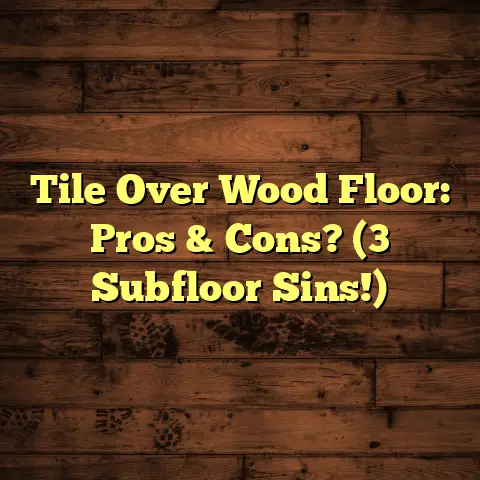Over Concrete Floor Outside? (3 Options Now!)
These days, everyone’s diving headfirst into outdoor hobbies. Gardening’s booming, outdoor kitchens are the new “it” thing, and creating cozy hangout spots for family? Forget about it – everyone wants in!
But that cold, hard concrete? It can really kill the vibe. It’s like trying to relax on a park bench when you could be sinking into a comfy armchair.
I’ve seen it all as a flooring contractor. And trust me, transforming that concrete into something amazing is easier than you think.
Let’s ditch the drab and dive into three awesome options that’ll totally revamp your outdoor space. We’re talking tiles, composite decking, and even outdoor rugs. Each has its own superpowers, ready to match your style, budget, and how you like to kick back outside.
Ready to make your outdoor space the envy of the neighborhood? Let’s do this!
Section 1: Option 1 – Outdoor Tiles
Introduction to Outdoor Tiles
Outdoor tiles? Think of them as the superheroes of the flooring world. They’re tough, they’re stylish, and they can totally transform a boring concrete slab into a stunning patio, walkway, or outdoor kitchen.
We’re talking materials like ceramic, porcelain, and even natural stone.
Ceramic tiles are a classic choice, known for their versatility and affordability. Porcelain tiles, on the other hand, are like the upgraded version – denser, more durable, and even more resistant to the elements.
And then there’s stone – think slate, travertine, or even granite. Stone tiles bring a natural, earthy vibe to any outdoor space.
The best part? The aesthetic appeal is off the charts. You can find outdoor tiles in a mind-boggling array of colors, patterns, and textures.
Want a Mediterranean vibe? Go for terracotta tiles. Modern and sleek? Large-format porcelain tiles are your best bet.
Benefits of Using Outdoor Tiles
Why choose outdoor tiles over other options? Let me break it down for you:
-
Durability and Weather Resistance: This is huge. Outdoor tiles are specifically designed to withstand the elements – rain, snow, sun, you name it. They won’t crack, fade, or warp like some other materials.
-
Easy Maintenance and Cleaning: Seriously, you can practically hose them down. Spills? No problem. Muddy footprints? Gone in seconds. A little soap and water is all you need.
-
Aesthetic Versatility: This is where you can really let your creativity shine. With so many styles, colors, and patterns to choose from, you can create a truly unique outdoor space that reflects your personal taste.
Real Talk: I once helped a client create a stunning mosaic patio using a mix of colorful ceramic tiles. It was a labor of love, but the end result was absolutely breathtaking. It completely transformed their backyard into a vibrant, inviting space.
Installation Process
Okay, let’s get down to the nitty-gritty. Installing outdoor tiles isn’t rocket science, but it does require some prep work and attention to detail.
Here’s a step-by-step guide:
-
Prepare the Concrete Surface: This is crucial. You need to make sure the concrete is clean, level, and free of any cracks or debris. Use a pressure washer to blast away any dirt or grime. If there are cracks, fill them with a concrete patching compound.
-
Gather Your Tools and Materials: You’ll need:
- Outdoor-rated tile adhesive (thin-set mortar)
- Grout
- Tile spacers
- A notched trowel
- A tile cutter (wet saw is best)
- A rubber mallet
- A level
- Safety glasses and gloves
-
Apply the Adhesive: Using the notched trowel, spread a layer of thin-set mortar over a small section of the concrete. Make sure the notches are consistent to ensure proper adhesion.
-
Lay the Tiles: Carefully place the tiles onto the mortar, using tile spacers to maintain consistent gaps. Gently tap each tile with the rubber mallet to ensure it’s firmly seated.
-
Cut Tiles as Needed: Use the tile cutter to cut tiles to fit around edges and corners.
-
Let it Cure: Allow the adhesive to cure for at least 24-48 hours before grouting.
-
Grout the Tiles: Mix the grout according to the manufacturer’s instructions and apply it to the tile joints. Use a grout float to push the grout into the joints, then wipe away any excess with a damp sponge.
-
Seal the Grout: Once the grout has cured, apply a grout sealer to protect it from stains and moisture.
Pro Tip: Proper drainage is key for outdoor tile installations. Make sure the concrete surface slopes slightly away from your house to prevent water from pooling.
Cost Considerations
Let’s talk money. The cost of outdoor tiles can vary quite a bit depending on the material, size, and style.
-
Ceramic Tiles: Generally the most affordable option, ranging from $1 to $5 per square foot.
-
Porcelain Tiles: A bit pricier, typically between $3 and $10 per square foot.
-
Stone Tiles: The most expensive option, ranging from $5 to $30 per square foot or more.
Then there’s the cost of installation. If you’re a DIYer, you can save money by doing it yourself. But if you’re not comfortable with tiling, it’s best to hire a professional.
Professional installation can add another $5 to $15 per square foot to the total cost.
Here’s a quick comparison:
| Item | DIY Cost (per sq ft) | Professional Cost (per sq ft) |
|---|---|---|
| Ceramic Tiles | $2 – $6 | $7 – $21 |
| Porcelain Tiles | $4 – $11 | $9 – $26 |
| Stone Tiles | $6 – $31 | $11 – $46 |
Best Use Cases
So, what kind of hobbies and activities are perfect for a tiled outdoor space? Here are a few ideas:
-
Yoga and Meditation: A smooth, level tile surface is ideal for yoga and meditation. Plus, the cool surface can be refreshing on a hot day.
-
Outdoor Dining: Tiled patios are perfect for outdoor dining. They’re easy to clean, so you don’t have to worry about spills.
-
Entertaining: A stylish tiled patio can be a great place to entertain guests. Add some comfortable seating, a fire pit, and you’re good to go!
I’ve seen clients create amazing outdoor kitchens with tiled countertops and backsplashes. It’s a great way to bring the indoors out and create a functional, stylish space for cooking and entertaining.
Section 2: Option 2 – Composite Decking
Introduction to Composite Decking
Composite decking is like the cool, low-maintenance cousin of traditional wood decking. It’s made from a blend of recycled wood fibers and plastic, which gives it the look of wood without all the hassle.
Think of it as the perfect solution for folks who love the aesthetic of wood but don’t want to spend their weekends sanding, staining, and sealing.
Composite decking comes in a variety of colors, textures, and styles, so you can find something that matches your taste. Some even have realistic wood grain patterns that look incredibly authentic.
Advantages of Composite Decking
So, why choose composite decking over wood or other materials? Here are a few compelling reasons:
-
Resistance to Rot, Splintering, and Fading: This is a big one. Unlike wood, composite decking won’t rot, splinter, or fade over time. It’s incredibly durable and can withstand even the harshest weather conditions.
-
Eco-Friendliness and Sustainability: Because it’s made from recycled materials, composite decking is an eco-friendly choice. You’re helping to reduce waste and conserve natural resources.
-
Comfort Underfoot and Slip Resistance: Composite decking is generally more comfortable to walk on than concrete or tile. Plus, many composite decking products have a textured surface that provides excellent slip resistance, even when wet.
Personal Story: I once had a client who was constantly battling rot and termites with their wood deck. They were spending a fortune on repairs and maintenance. I suggested composite decking, and they haven’t looked back since. They love the fact that they can spend their time enjoying their deck instead of working on it.
Installation Guide
Installing composite decking over concrete requires a slightly different approach than installing it over a traditional wood frame.
Here’s a general overview of the process:
-
Prepare the Concrete Base: Just like with tile, you need to make sure the concrete is clean, level, and free of any cracks or debris.
-
Create a Framing System: Since you can’t attach the decking directly to the concrete, you’ll need to create a framing system using pressure-treated lumber or composite sleepers. These sleepers will provide a solid base for the decking boards.
-
Attach the Sleepers to the Concrete: Use concrete screws or adhesive to attach the sleepers to the concrete. Make sure they’re evenly spaced and level.
-
Install the Decking Boards: Follow the manufacturer’s instructions for installing the decking boards. Most composite decking products use hidden fastener systems that create a clean, seamless look.
-
Add Finishing Touches: Install fascia boards around the perimeter of the deck to cover the framing system and give it a finished look.
Important Note: Always follow the manufacturer’s instructions for installing composite decking. Proper installation is essential for ensuring the longevity and performance of the deck.
Cost Analysis
Composite decking is generally more expensive than traditional wood decking, but the long-term benefits can outweigh the initial cost.
Here’s a breakdown of the costs:
-
Composite Decking Materials: Expect to pay between $3 and $12 per square foot for composite decking materials.
-
Framing Materials: The cost of framing materials will depend on the size and complexity of the deck. Expect to pay between $1 and $3 per square foot.
-
Installation Costs: Professional installation can add another $5 to $10 per square foot to the total cost.
Here’s a cost comparison between traditional wood and composite decking:
| Item | Traditional Wood (per sq ft) | Composite Decking (per sq ft) |
|---|---|---|
| Materials | $2 – $8 | $4 – $15 |
| Installation | $4 – $8 | $5 – $10 |
| Total (approx) | $6 – $16 | $9 – $25 |
While composite decking has a higher upfront cost, it requires less maintenance than wood decking. You won’t have to worry about sanding, staining, or sealing, which can save you a significant amount of money over the lifespan of the deck.
Ideal Activities
What kind of hobbies and activities are perfect for a composite deck? Here are a few ideas:
-
Barbecues and Outdoor Cooking: A composite deck is a great place to set up a barbecue grill and enjoy outdoor cooking. It’s easy to clean, so you don’t have to worry about spills.
-
Lounging and Relaxing: Add some comfortable lounge chairs and a hammock, and you’ve got the perfect spot for relaxing and soaking up the sun.
-
Outdoor Games: A composite deck can be a great place to play outdoor games like cornhole or ladder toss.
I’ve seen clients create amazing outdoor living spaces with composite decks. They add outdoor furniture, fire pits, and even outdoor TVs to create a comfortable, inviting space for entertaining and relaxing.
Section 3: Option 3 – Outdoor Rugs
Introduction to Outdoor Rugs
Outdoor rugs are like the instant-gratification solution for sprucing up your outdoor space. They’re a quick, easy, and affordable way to add color, texture, and comfort to a boring concrete slab.
Think of them as the perfect accessory for any outdoor space. They come in a wide variety of colors, patterns, and sizes, so you can find something that matches your style.
Most outdoor rugs are made from materials like polypropylene or recycled plastics, which are designed to withstand the elements.
Benefits of Outdoor Rugs
Why choose outdoor rugs over other flooring options? Here are a few reasons:
-
Versatility in Design and Color Options: Outdoor rugs come in a mind-boggling array of designs and colors. You can find everything from bold geometric patterns to subtle floral designs.
-
Softness and Comfort Underfoot: Outdoor rugs add a layer of softness and comfort to a hard concrete surface. They’re perfect for bare feet!
-
Easy to Clean and Maintain: Most outdoor rugs are incredibly easy to clean. You can simply hose them down or spot-clean them with soap and water.
Real Talk: I had a client who was on a tight budget but wanted to add some personality to their patio. I suggested an outdoor rug, and they were amazed at how much it transformed the space. It added color, texture, and a sense of coziness.
Placement and Sizing
Choosing the right size and placement for your outdoor rug is essential for creating a cohesive and inviting space.
Here are a few tips:
-
Define Your Space: Use an outdoor rug to define a specific area, such as a seating area or dining area.
-
Size Matters: Choose a rug that’s large enough to anchor your furniture. The front legs of your chairs and sofas should be on the rug.
-
Consider the Shape: Rectangular rugs are great for defining long, narrow spaces, while round rugs are perfect for creating a focal point.
Here’s a quick guide to rug sizes:
| Area Size | Recommended Rug Size |
|---|---|
| Small Patio (8×10) | 5×7 or 6×9 |
| Medium Patio (10×12) | 8×10 or 9×12 |
| Large Patio (12×15+) | 10×14 or larger |
Cost Breakdown
Outdoor rugs are generally the most affordable flooring option.
Here’s a breakdown of the costs:
-
Outdoor Rugs: Expect to pay between $20 and $500 or more for an outdoor rug, depending on the size, material, and design.
-
Rug Pad (Optional): A rug pad can add extra cushioning and prevent the rug from slipping. Expect to pay between $10 and $50 for a rug pad.
Here’s a cost comparison to other flooring options:
| Item | Cost (per sq ft) |
|---|---|
| Outdoor Rugs | $1 – $10 |
| Ceramic Tiles | $2 – $31 |
| Composite Decking | $4 – $25 |
Best Activities for Outdoor Rugs
What kind of hobbies and activities are perfect for an outdoor rug? Here are a few ideas:
-
Reading and Relaxing: An outdoor rug provides a soft, comfortable surface for reading and relaxing. Add some pillows and a blanket, and you’re good to go!
-
Picnicking: An outdoor rug is a great alternative to a picnic blanket. It’s easy to clean and provides a comfortable surface for eating and lounging.
-
Children’s Play Areas: An outdoor rug can create a soft, safe play area for children.
I’ve seen clients create cozy outdoor reading nooks with outdoor rugs, comfortable chairs, and string lights. It’s the perfect place to escape and unwind.
Conclusion
So, there you have it – three awesome options for flooring over concrete outside!
We talked about:
-
Outdoor Tiles: Durable, stylish, and perfect for creating a permanent outdoor space.
-
Composite Decking: Low-maintenance, eco-friendly, and ideal for creating a wood-like deck.
-
Outdoor Rugs: Affordable, versatile, and a quick way to add color and comfort to your patio.
Each option caters to different hobbies, budgets, and personal preferences.
Think about how you want to use your outdoor space and what kind of vibe you’re going for.
Do you want a sophisticated outdoor dining area? Go for tiles.
A relaxed, comfortable lounge space? Consider composite decking.
A quick and easy way to add some personality? Outdoor rugs are your best bet.
No matter what you choose, remember that creating a functional and inviting outdoor space can transform your lifestyle. It’s a place to relax, entertain, and enjoy your favorite hobbies.
So, get out there and make your outdoor dreams a reality! Your perfect outdoor oasis is waiting.




